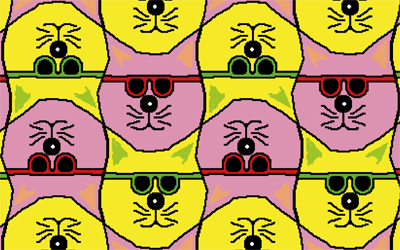Home > Patterns > Misunderstandings > Tessellations > Making tessellations
Making tessellations
Start by asking students to make patterns by fitting pattern blocks together. If their pattern has no gaps, it will be a tessellation.
Some of students' tessellations will be regular in some way, so that they can be extended indefinitely in all directions. For the repeating patterns, ask students to identify the unit of repeat.
Students can also draw their own tessellations by drawing around the pattern blocks. They can then colour in their drawing to make a colour pattern (not necessarily the colours of the pattern blocks).
Students will enjoy using the virtual manipulative Pattern Blocks to create and explore even more patterns. In each pattern, encourage students to look particularly at the way the various blocks fit together. They should also look for symmetry in their patterns.
The Dutch artist M. C. Escher created many fantastic works by inventing his own figures that formed tessellations. This tessellations website is full of suggestions on how students can create their own tessellations using Escher’s ideas.

